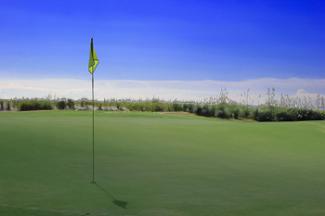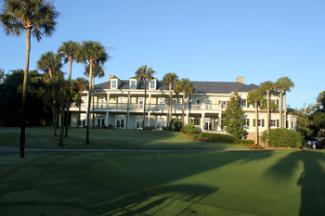Featured Golf News
Don't Miss Turtle Point GC in Charleston
I love Lowcountry golf. You get spoiled real easy: flat fairway lies; manicured Bermuda grass propping the golf ball up like it was on a tee; the sounds and sights of wildlife all around, the fabulous eye-candy of the wetlands, marshes and ocean tingling the senses; and warm ocean breezes. Yeah, for my money it's hard to beat the courses of coastal South Carolina.

The 7th Hole at Turtle Point
My buddy, photographer Mark William Paul, and I tasted one such treat on a recent visit to Charleston after Mike Vegis, the affable director of public relations for Kiawah Resort complex on Johns Island, invited us to test out the Jack Nicklaus-designed Turtle Point Golf Course. The layout is one in a stable of five daily-fee courses at the resort, the most famous, of course, being the Ocean Course, which has hosted numerous big events including the Ryder Cup and PGA Championship.
For my money, Turtle Point is the second-best of the group, and is rather unheralded, existing in the shadow of its more famous sister course just a mile or so away. Nicklaus created a beauty that winds through the marshes before it rambles (for three holes) alongside the Atlantic Ocean, the latter feature being perhaps its most significant attribute and calling card.
It was a somewhat misty morning when we teed off and the day almost got off to a poor start when I duck-hooked my first drive toward a pond on the left side of the par-4, splashing into the water a mere few feet from a majestic snowy egret munching on its breakfast. As we watched in horror, the bird escaped damage and I was left to wonder how hitting the bird would have gone over with Vegis and the maintenance crew, never mind having to likely fill out all kinds of environmental reports had the bird met an untimely demise at the hands of a half-awake golfer.

Turtle Point's 15th Green
Thus shaken, I proceeded to hack up the hole, and a few more, before settling down and playing better, which Turtle Point allows you to do if you hit the ball straight off the tee and take what each hole gives you. For example, both Mark and I hit desultory drives on the 388-yard par-4 sixth and were left with long second shots to a green protected left and partially in front by water. I took out my trusty hybrid, aimed for the safe right side of the green, and was left with a 30-foot putt for a two-putt par.
The front nine ends with a dandy 428-yard par-4 that demands a strong tee shot to the right side of the fairway and then another smart approach favoring the right side on the dogleg-left. There's water left so the bailout is right. I managed a par for a solid conclusion to the front nine, especially after the near-disaster on the first tee.
A few words about the greens at Turtle Point: How about simply the best I've ever played? Mark agreed. Course superintendent Steve Agazzi and his staff do a remarkable job as a whole here, but the putting surfaces are like soft carpets with nary a blemish. They roll fast and true, which makes putting a delight, the ball never bouncing unexpectedly. Just awesome.

The 16th Green at Turtle Point
I think one the best holes, with the exception of the holes along the ocean, is No. 11, a dogleg-right, 408-yard par-4 with water along the right starting at about 150 yards and bisecting the fairway in front of the green.
We worked our way to the much-heralded stretch of holes beside the Atlantic and found them stunning. The 14th is a 174-yard par-3 that plays out of a chute of bushes. You can hear the ocean roaring as you walk to the tee, which only adds to the visceral anticipation of the moment. Its small, elevated green affords a look at the sparkling ocean. It's hard not to gape at the multi-million-dollar homes gracing the left side of the 14th and wonder what it would take to call one of these beauties home, or second, or third homes. That's the way it is at Kiawah, one of the most prized addresses in the nation.
The 15th is a 385-yard par-4 with the ocean all along the left. It's easy to get distracted here by the natural beauty of the surroundings and pounding of nearby surf.

The Closing Hole at Turtle Point
The 16th is a par-3 of 179 yards that again plays out of a chute of sea shrub. There are waste areas all around the green. Number 18 is a tough finisher that stretches 434 yards from the tips. You need a good drive to reach a narrow landing area and then a crisp mid-iron over water to find a green on a peninsula.
While not overly long, Turtle Point asks you to approach each hole thoughtfully. There is water or marsh pretty much everywhere and fairway and greenside bunkers that complicate matters. A good short game is essential here, as there are testy chips if you miss the greens by only a bit. In addition to being on the fast side, the putting surfaces are somewhat undulating and can be tricky to read. The wind was down when we played, which was a plus. If it is coming hard off the ocean, club selection can become difficult.

Turtle Point's Stately Clubhouse
(All Photos by Mark William Paul)
The course plays 7,061 yards from the way-back tees. For a more enjoyable round I'd suggest moving down to the markers at 6,503 yards or even 6,210. We bounced back and forth between the tees and the course has plenty of bite at whatever distance you play from.
Turtle Point is about as good as golf gets and is one course you don't want to miss in the Charleston area. For more information, visit www.kiawahresort.com.
John Torsiello is an editor/writer living in Connecticut. He has written extensively about all aspects of the golf industry for a number of national and regional publications. He is a regular contributor to "Golf Course Industry," "Lawn and Landscape," "Golfing" and "Fairway Living" magazines as well as various online publications. He has strong, ongoing relationships with industry professionals and has worked closely with course owners, architects, developers, course superintendents and general managers around the country. He has won a number of awards for his writing, including first place from the Turf and Ornamental Communicators Association for a piece that appeared in "Golf Course Industry" magazine.
Story Options
 |
Print this Story |
